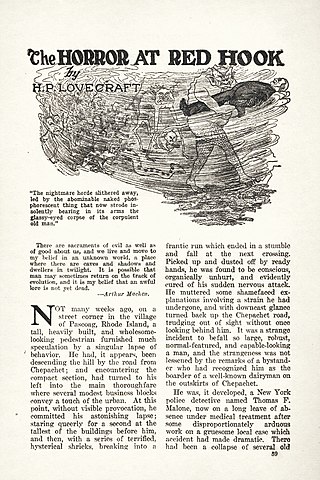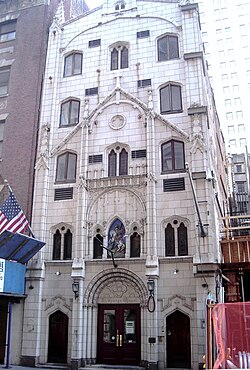
Carroll Gardens is a neighborhood in the northwestern portion of the New York City borough of Brooklyn. Taking up around 40 city blocks, it is bounded by Degraw and Warren Streets (north), Hoyt and Smith Streets (east), Ninth Street or the Gowanus Expressway (south), and Interstate 278, the Gowanus and Brooklyn–Queens Expressways (west). The neighborhoods that surround it are Cobble Hill to the northwest, Boerum Hill to the northeast, Gowanus to the east, Red Hook to the south and southwest, and the Columbia Street Waterfront District to the west.


The Basilica of Saint Patrick's Old Cathedral, sometimes shortened to St. Patrick's Old Cathedral or simply Old St. Patrick's, is a Catholic parish church, a basilica, and the former cathedral of the Archdiocese of New York, located in the Nolita neighborhood of Lower Manhattan, New York City. Built between 1809 and 1815 and designed by Joseph-François Mangin in the Gothic Revival style, it was the seat of the archdiocese until the current St. Patrick's Cathedral in Midtown Manhattan opened in 1879. Currently, liturgies are celebrated in English, Spanish, and Chinese. The church is at 260–264 Mulberry Street between Prince and Houston streets, with the primary entrance on Mott Street. Old St. Patrick parish merged with Most Precious Blood parish, and the two churches share priests and administrative staff.

Francis Hatch Kimball was an American architect practicing in New York City, best known for his work on skyscrapers in lower Manhattan and terra-cotta ornamentation. He was an associate with the firm Kimball & Thompson. His work includes the Empire Building, Manhattan Life Insurance Building, and Casino Theatre. All but one of Kimball's work was in the United States.

"The Horror at Red Hook" is a short story by American writer H. P. Lovecraft, written on August 1–2, 1925. "Red Hook" is a transitional tale, situated between the author's earlier work and the later Cthulhu Mythos. Although the story depicts a sinister cult, this cult offers a conventionally occult devil-worshipping threat, rather than the cosmic threat depicted in his later work. Living in poverty in the slum of Red Hook at the time of writing, Lovecraft was at this time urgently attempting to widen his markets in the pulp magazines. By having an unusually proactive Irish New York police detective as his protagonist, he hoped for a swift sale to a detective pulp, which would have opened up a new market other than his usual Weird Tales magazine. He did not get such a sale, and had to fall back on Weird Tales. "Red Hook" was thus first published in the January 1927 issue of Weird Tales.

The Church of St. Vincent Ferrer is a Roman Catholic parish in the Upper East Side of Manhattan, New York City. It was built in 1918 by the Dominicans; the attached priory serves as the headquarters of the Eastern United States Province of the order. Its architecture has some unusual features: above the front entrance is one of the few statues of the Crucifixion on the exterior of an American Catholic church; and inside, the Stations of the Cross depict Christ with oil paintings instead of statuary or carvings. It has two Schantz pipe organs. The church building, at the corner of Lexington Avenue and East 66th Street in the Lenox Hill section of the Upper East Side, has been called "one of New York's greatest architectural adornments."

St. Cecilia Church is a Roman Catholic parish church in the Roman Catholic Archdiocese of New York and a historic landmark located at 120 East 106th Street between Park Avenue and Lexington Avenue, Manhattan, New York City, New York. The parish was established in 1873. It was staffed by the Redemptorist Fathers from 1939 to 2007. The church was designated a New York City landmark in 1976. The church and convent were listed on the U.S. National Register of Historic Places in 1984.

The Flatbush Reformed Protestant Dutch Church, also known as the Flatbush Reformed Church, is a historic Dutch Reformed church – now a member of the Reformed Church in America – at 890 Flatbush Avenue in the Flatbush neighborhood of Brooklyn, New York City. The church complex consists of the church, cemetery, parsonage and church house.

Church of St. Thomas the Apostle is a former Roman Catholic parish church in New York City that had been threatened with demolition. It was the subject of a landmarks preservation debate. The parish was established in 1889; staffed by the Salesians of Don Bosco from 1979 to 2003; and closed in 2003 because of a diminished congregation and structural problems.

The Church of St. Paul the Apostle is a Catholic church on the Upper West Side of Manhattan in New York City. It is the mother church of the Paulist Fathers, the first religious community of Catholic priests founded in the United States.

The Church of the Transfiguration is a Roman Catholic parish located at 25 Mott Street on the northwest corner of Mosco Street in the Chinatown neighborhood of Manhattan, New York City. The parish is under the authority of the Archdiocese of New York and is staffed by the Maryknoll order.

Little Syria was a diverse neighborhood that existed in the New York City borough of Manhattan from the late 1880s until the 1940s. The name for the neighborhood came from the Arab speaking population who emigrated from Ottoman Syria, an area which today includes the nations of Lebanon, Syria, Jordan, and Palestine. Also called the Syrian Quarter, or Syrian Colony in local newspapers it encompassed a few blocks reaching from Washington Street in Battery Park to above Rector Street. This neighborhood became the center of New York's first community of Arab speaking immigrants. In spite of this name the neighborhood was never exclusively Syrian or Arab, as there were also many Irish, German, Slavic, and Scandinavian immigrant families present.

The Church of Our Lady of Lourdes is a parish church in New York City, under the jurisdiction of the Archdiocese of New York, located at 463 West 142nd Street between Convent and Amsterdam Avenues in Manhattan.

The Church of St. Elizabeth of Hungary is a Roman Catholic parish church in the Roman Catholic Archdiocese of New York, located at 211 East 83rd Street, between Second and Third Avenues, on the Upper East Side of Manhattan, New York City.

Our Lady of Lebanon Cathedral is a Maronite Catholic cathedral located in Brooklyn, New York, United States. It is the seat of the Eparchy of St. Maron of Brooklyn. It is located in the neighborhood of Brooklyn Heights in the oldest northwest section of the borough, across the East River from Manhattan. The church building originally housed the "Church of the Pilgrims" of the old Congregational Christian Church,.





















